John Adams would definitely tip his hat to Morgan Hill this
holiday weekend. Describing how he wished to annually celebrate the
birthday of the United States, the founding father wrote his wife
Abigail on July 3, 1776:
“It ought to be solemnized with Pomp and Parade.”
John Adams would definitely tip his hat to Morgan Hill this holiday weekend. Describing how he wished to annually celebrate the birthday of the United States, the founding father wrote his wife Abigail on July 3, 1776: “It ought to be solemnized with Pomp and Parade.”
Now in the 21st century Monday morning, the South Valley community faithfully carried out Adams’ wish with a two-hour long grand pageant celebrating the American spirit.
The Morgan Hill Independence Day parade, of course, doesn’t put itself together. It takes a small legion of dedicated volunteers working many hours to prepare and organize such an undertaking. And on the morning of the parade, I felt proud to participate as a volunteer marshal at West Dunne and Del Monte avenues.
My duty was to make sure spectators and parade participants were kept safe at that intersection during the event. Also volunteering at that same crossing was my friend Jonathan Medina, a Hollister native, up from his Ventura County home for the holiday weekend.
No doubt, Adams got it right about “Pomp and Parade.” There’s something uniquely American about a Fourth of July procession when a community marches along in united pride to celebrate our freedoms and liberties.
Observing the parade participants making their way along the street, and listening to the cheers and waves from the sidewalk crowds, I felt in a deep sense that America is truly a family. We share a birthday gift given to us all on July 4, 1776 with the passing of the Declaration of Independence. We’re all tied together by the bond of a common legacy of freedom.
During the Morgan Hill parade, you could see this bond in the faces of the children who marched along in their gymnastic or karate clubs, or in their equestrian groups, or playing stirring Sousa melodies in their high school marching bands.
You could also see it in those youngsters who sat crossed-legged on the street curb asphalt and stared in wonder at the parade units passing by.
From toddlers to teens, their faces showed the promise of America’s future. You could also see that American family bond in the faces of the senior citizens, both spectators and parade participants, who in their own lives, have played their individual roles in our nation’s story. Their faces detail the endurance of the democracy given to us by a document declaring our independence 229 years ago.
Watching the parade, you could see the connection in the faces of those who have served their country in war and in peace. You could also see it in the faces of their family members who bear the weight of worry for their beloved son or daughter or mother or father who heeded the call to arms.
As the South Bay Blue Star Moms marched by, proudly displaying photos of their children in military service, the parade spectators at Del Monte and West Dunne unleashed a torrent of applause and cheers in gratitude.
The moment proved that we are a family.
Back on the day our nation was born, no one could foresee what Thomas Jefferson’s document might mean to future generations in American cities and towns like Morgan Hill that at that time did not yet exist. I wonder how many of those men and women who served the cause of liberty during the American Revolution ever truly grasped how they marched in a great parade of history.
Morgan Hill’s Independence Day parade honors them for paying the price – often their own lives – for us to journey down a highway of liberty.
But perhaps they might have had a small inkling where that freedom road might one day lead. In his letter to Abigail, John Adams wrote:
“I am well aware of the Toil and Blood and Treasure, that it will cost Us to maintain this Declaration, and support and defend these States. Yet through all the Gloom I can see the Rays of ravishing Light and Glory. I can see that the End is more than worth all the Means, and that Posterity will tryumph in that Day’s Transaction.”
As a marshal at Morgan Hill’s parade, and as a proud member of that “Posterity” Mr. Adams referred to, I tip my own hat to the men of Second Continental Congress who put ink to parchment in Philadelphia on July 4, 1776. And I hope somehow they might know that, indeed, for Americans throughout the South Valley, the end was more than worth all the means.







